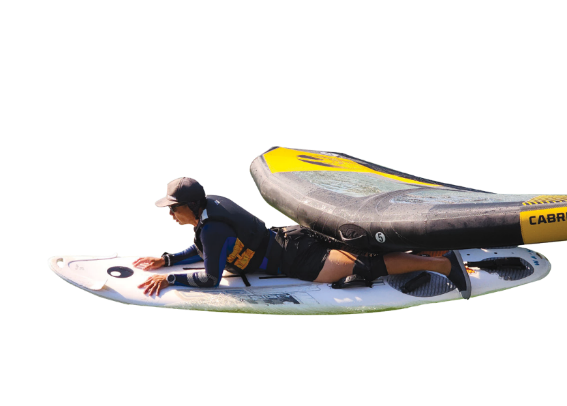 Leisure and Cultural Services Department - Community Sports Club BulletinLeisure and Cultural Services Department
Leisure and Cultural Services Department - Community Sports Club BulletinLeisure and Cultural Services Department
Sports Recommendation
Wingfoiling
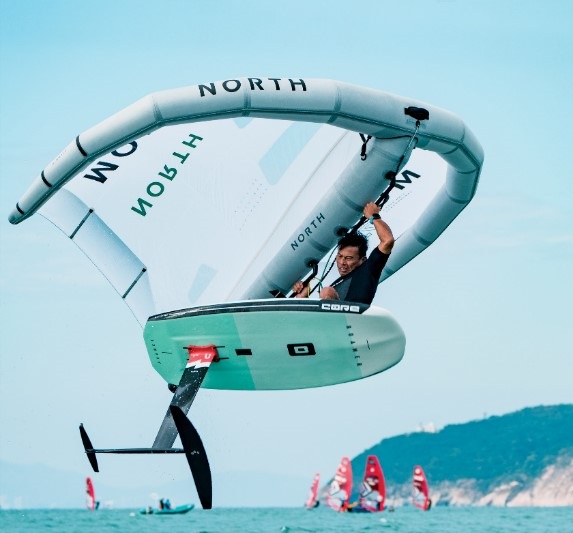
Since LEE Lai Shan, the “Queen of the Wind,” won Hong Kong’s first Olympic gold medal at the Atlanta Olympics Games in 1996, windsurfing has become known to every household. In recent years, another water sport similar to windsurfing, wingfoiling, has taken the world by storm and become hugely popular in Hong Kong.
As a matter of fact, wingfoiling has developed rapidly across the globe. The first ever European Championship was held in Saint Moritz, Switzerland in 2021. Moreover, wingfoiling will be included as an official event in the 2023 World Beach Games in Bali, Indonesia.
Introduction to wingfoiling
Originated in the United States, wingfoiling as a sport took shape as early as 1980. Back then, the gear used was a windsurfing board and a frame-supported wing connected by a short rod.
In modern wingfoiling, power is generated from an inflatable wing. Beginners should start with a windsurfing board first, then switch to a hydrofoil board after mastering the skills required to control the wing. Normally, surfers stand on a windsurfing board or hydrofoil board and hold tightly onto the handles on the wing, while gliding the board across the water surface with the use of wind energy. Given the wing is not connected to the windsurfing board or hydrofoil board, surfers must not only control the wing, but also make effective use of their body to transmit the power generated from the wing to their feet through torso to facilitate high-speed gliding. If a hydrofoil board is used, the hydrofoil installed below the board will produce upward thrust arising from acceleration, lifting the surfer and the full set of gear above the water surface at a suitable speed. As long as the weight distribution of a surfer is properly adjusted and a steady speed is kept, the hydrofoil will generate sustained upward thrust, allowing the surfer to glide above the water surface.
Wings come in varying sizes, so surfers can choose a suitable one according to their own skill level or usage requirements. To put it simply, a larger wing is more suitable for generation of greater power under light wind conditions; while use of a smaller wing is preferred when the wind becomes strong, for it is increasingly difficult to control the wing if the power so generated becomes too intense.
There are various types of hydrofoils that come in different sizes and shapes. The smaller they are, the higher the speed will be required to generate sufficient upward thrust. Beginners are therefore advised to choose a larger hydrofoil, which can create considerable upward thrust even under low wind conditions.
As surfers may glide above the sea surface with hydrofoils at a high speed with low noise level, they are very prone to accidents. To avoid dangers, they must pay due attention to water safety and be always considerate of other sea users’ needs. Once realising that they are heading in the same direction as other users, they should stay alert early on and change courses when necessary to avoid collisions.
Wingfoiling gear
Wingfoiling requires the use of gear similar to windsurfing. Subject to weather and coastal conditions, surfers must wear suitable warm or sun-resistant clothing, rubber shoes for water sports, and comfortable tight-fitting buoyancy aids. When using a hydrofoil board, they must wear helmets for enhanced protection.
Naming of the sport
|
When wingfoiling was first introduced to Hong Kong, many suggested such Chinese translations as |
|
|
“風翼滑浪”, “水翼滑浪”, “滑浪風翼”, “風翼水翼” and “水翼滑浪風翼” for consideration. In February 2022, the Windsurfing Association of Hong Kong (WAHK) conducted an online poll via social networking platform for the public to vote their favourite Chinese name for the sport. Ultimately, “滑浪風翼” turned out to get most votes in the poll, subsequent to which the WAHK decided to adopt it as the official Chinese name of the sport. |
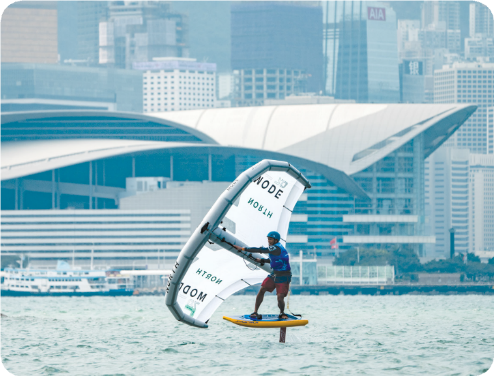 |
Development of wingfoiling in Hong Kong
Wingfoiling was introduced to Hong Kong between 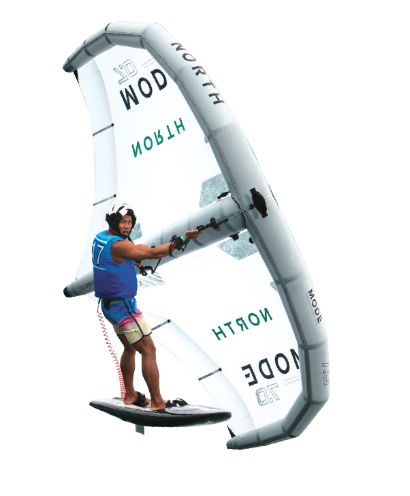 around 2018 and 2019. Back then, only very few windsurfing fans were eager to give it a try. The number of wingfoiling participants has doubled in recent years. In view of this, the WAHK held the first ever Hong Kong Wingfoil Race 2022 at Tai Tam Bay, Stanley in May 2022, attracting about 50 wingfoiling athletes from different backgrounds, many of
around 2018 and 2019. Back then, only very few windsurfing fans were eager to give it a try. The number of wingfoiling participants has doubled in recent years. In view of this, the WAHK held the first ever Hong Kong Wingfoil Race 2022 at Tai Tam Bay, Stanley in May 2022, attracting about 50 wingfoiling athletes from different backgrounds, many of 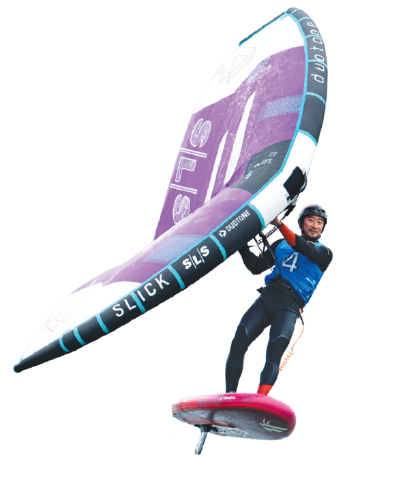 whom being professional athletes including Hayley Victoria CHAN, the current captain of the Hong Kong windsurfing team, and HO Chi Ho, a former Hong Kong windsurfing representative at the Olympics, who won the championship and secured the first runner-up spot respectively. On 3 and 4 December 2022, the WAHK held Asia’s first series qualifiers recognised by the Global Wingsports Association, where elite wingfoilers from around the globe gathered in Hong Kong to compete in exciting races.
whom being professional athletes including Hayley Victoria CHAN, the current captain of the Hong Kong windsurfing team, and HO Chi Ho, a former Hong Kong windsurfing representative at the Olympics, who won the championship and secured the first runner-up spot respectively. On 3 and 4 December 2022, the WAHK held Asia’s first series qualifiers recognised by the Global Wingsports Association, where elite wingfoilers from around the globe gathered in Hong Kong to compete in exciting races.
|
There are two major categories in wingfoiling competitions:
|
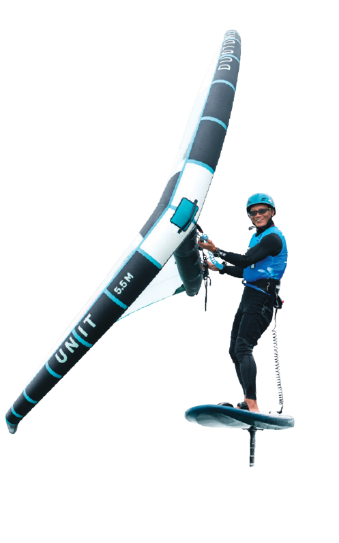 |
|
The mode is similar to that of traditional windsurfing competitions, in which participants start together to complete the designated lap as fast as possible. The surfer completing the designated route in the shortest time will be declared winners. |
|
|
Surf-freestyle |
|
|
Participants must perform various tricks such as loops and spins in the designated lap within the specified time. Judges will give scores based on factors such as the degree of difficulty, style and versatility of their tricks. |
To further enhance its members’ and the public’s understanding of wingfoiling and raise their safety awareness, the WAHK issues safety guidelines for wingfoiling enthusiasts; formulates training plans; actively trains coaches; and plans to launch related courses in the upcoming summer to teach more people about wingfoiling and the key points in safe use of gear, in a bid to ensure their maximum enjoyment of this emerging sport.
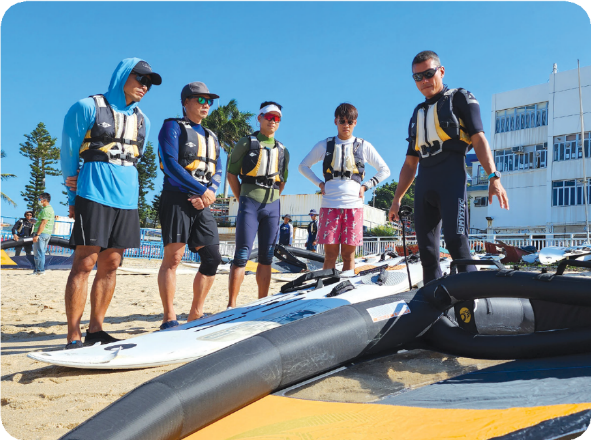
|
Safety guidelines for wingfoiling
|

